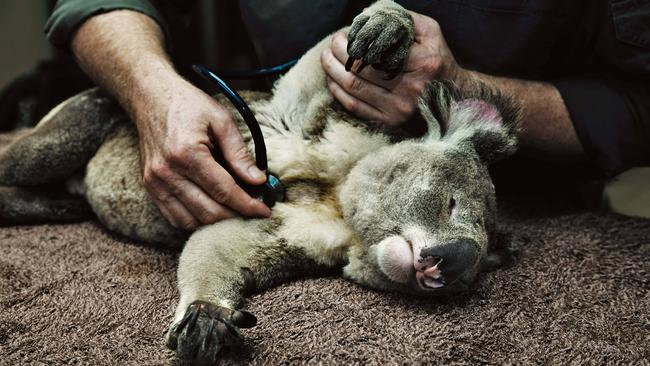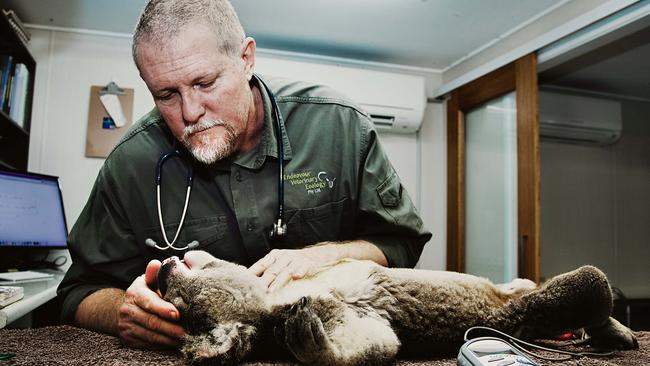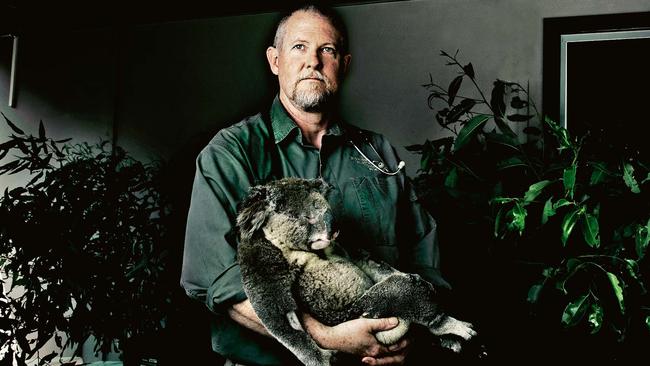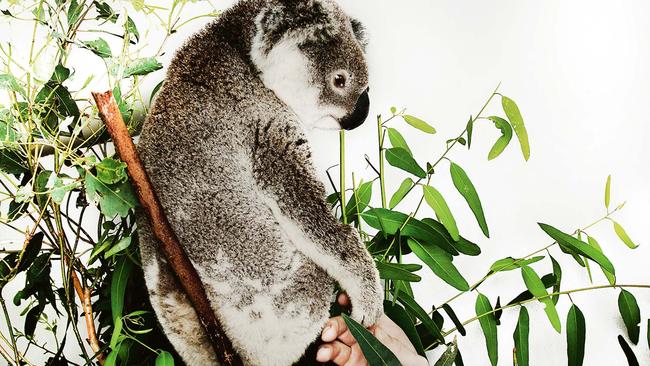Queensland koala colony’s survival story
The bushfires have been devastating for koalas. But in one part of the country at least, there’s hope.

Amelia has a fever and pain from cystitis and Rocky’s eyes are caked with conjunctivitis. They look a bit surprised to find themselves in the vet hospital, sequestered near seven other sick koalas. These are the lucky ones – while their afflictions were acquired in the Queensland summer heat when koalas get up close and personal with each other and share diseases, they were picked up almost as soon as they fell ill because this population is under surveillance intense enough to impress the most skilled spy.
Amelia and Rocky will probably survive their ordeals and return to their range, another step in the journey to reverse koala fortunes in a strip of bush surrounded by earth-shaking development, north of Brisbane. Here, they are not just surviving but multiplying – a beacon of hope amid the widespread destruction of the marsupials and their habitat in bushfires further south. Koala numbers in south-east Queensland and NSW have long been under pressure but here more than 20 joeys have been born in the past 12 months and adult deaths have declined. While human interference is regularly highlighted as the bringer of all that is bad for koalas, in this remnant corridor they flourish because of humans.
This unlikely scenario is no accident. The largest and most comprehensive koala tracking program ever undertaken was developed seven years ago when the Queensland Government pushed through a 12.6km rail line, linking the bay at Redcliffe, north of Brisbane, with the 130-year-old Petrie line. The Moreton Bay Rail Link was to take out 62ha of koala habitat and 21,000 trees they feed on. Nearly 25,000 suitable trees were eventually replanted, but even before the construction phase the koalas were struggling because of disease and disruption. Recognising that dead koalas are the worst kind of public relations setback during a major infrastructure project, the Queensland Transport and Main Roads Department didn’t hold back financially in trying to shore up the animals’ chances of survival. Mitigation measures were undertaken, with wild animal tunnel access points under the rail line and fencing to help keep animals and trains apart.

But more had to be done, so wildlife veterinarian and researcher Dr Jon Hanger and his Endeavour Veterinary Ecology team were brought in to monitor the koalas in a way that had never been possible because of the costs and time required. Their investigation area took in one kilometre either side of the railway line – a vast area – and they incrementally fitted more than 500 koalas with tracking devices and assessed their health: treating injuries and illnesses and vaccinating them against the diseases that had ravaged their numbers.
Only 390 of those animals were healthy at the first examination. And when the tracked koalas died – and they did quite often early in the project – Hanger’s team could sometimes locate the bodies and find out why. A dozen or so were hit by vehicles, and complications from ailments such as chlamydial disease and infections claimed five times that many.
The surprise biggest killer was unveiled by the tracker data: wild dogs. “In all honesty, we were floored by the extent these wild dogs were affecting the numbers,” Hanger says. “By dogs, I mean they were dingoes and dingo crosses, not feral or domestic ones. We had more than 100 dead koalas in the first two years because of them – it was a really terrible situation and many of those koalas had awful deaths.” Through ongoing surveillance they discovered that just one individual animal was responsible for more than half the koala deaths, killing some outright and leaving others maimed. It took three and a half years for him to be caught. “Once he was gone, it was like night and day – the koala numbers stabilised, then grew,” Hanger says.
Hanger is best known publicly for setting up the Australia Zoo Wildlife Hospital and being late conservationist Steve Irwin’s chief vet. But in research circles his profile is higher and his team at Endeavour Veterinary Ecology is renowned for koala research projects that parallel infrastructure developments, using technology including Bluetooth and radio tracking as well as good, old-fashioned observation. His purpose-built clinic nestled on a rugged bush block in Toorbul, east of Caboolture, is home base for the koala medical care his team delivers.
Just up the road at the University of the Sunshine Coast at Sippy Downs is Professor Peter Timms, a microbiologist recognised for his expertise in chlamydial disease. Timms and Hanger have been colleagues for more than a decade and Timms’ vaccines have been tested and distributed by Hanger’s team. Together, and with government funds, they gathered and mined data on the rail link koalas that showed, Hanger says, “that the koalas there were pretty distinctly on an extinction trajectory when we started but then by the second or third year, we had reversed that. Of course, that was pleasing and what we had hoped for. And it proved a lot of those doubters and doomsayers wrong, which was satisfying too.”
There are some in the koala conservation world who believe any human intervention is bad for koalas’ survival, and that development and habitat loss contribute to nutritional stress and disease. But with koala populations declining even in some secure bushland spaces untouched by bulldozers, Hanger says that where development must happen, intense monitoring and management can enable koalas and humans to coexist. That’s not to say he’s pro-development. He has a policy of not advising developers to help them win approvals, only coming on board once the project is secured. Development, sustainability and conservation might be strange bedfellows, but he is adamant they must unite if koalas are to dodge extinction.

Before the devastating bushfires of this summer, the best estimates put koala numbers at between 120,000 and 300,000 left in the wild, but even then no one was sure because they are notoriously hard to find and count. Koalas have been listed as vulnerable to extinction, just a step below endangered, since 2012 under the Environment Protection and Biodiversity Conservation Act in NSW, the ACT and Queensland. With 10 million hectares of land razed in fires across the country, Environment Minister Sussan Ley has asked that the Threatened Species Scientific Committee reassess koalas’ status, mooting that they may be moved to endangered status in some parts of the country. The scale of the destruction is still being mapped, with suggestions that more than 1.25 billion animals overall will have died either by fire or as a result of habitat loss, compromised food sources and predators.
For a creature so lauded and loved, koalas lack resilience. Other native animals have a chance to run, hop or fly away from flames, but koalas’ only real defence is to climb higher in a tree, which amounts to suicide. They can’t run when the bulldozers move in. They are also extraordinarily picky eaters, dining on only 40-50 of the 900 eucalypt species and even then, only selecting the right leaf tips. They are rare in the animal kingdom in opting for death over diversification of diet. Despite obvious physical differences, with koalas in cooler climes more robust and darker than those in the north, there is only one species of koala. They are shaped by their surrounds and the conditions that constitute their range.
While experts concur that no single event or element is likely to wipe them out any time soon, koalas are in a world of trouble in many areas where once they flourished. Even before the fires, NSW had an inquiry into how policies and funding might improve their predicament; public demand for considered development is keeping pace with society’s appetite for greater wildlife protection. Part of the solution, most planners and policy makers know, is to ensure development gives more than a modicum of regard to wild spaces.

After three sometimes bumpy years, the Moreton Bay Rail Link project finished with the koala population in better shape than most stakeholders had feared, with the population that was once on an extinction path holding on and showing signs of rejuvenation. The project charted the birth of more than 100 joeys in the corridor. More than 150 animals died or had to be euthanised due to trauma, and another 50 due to illness. Just as Hanger’s team started the laborious process of removing the tracking collars three years ago, the project at an end, a second wave of luck rolled in.
The Moreton Bay Regional Council, which had been responsible for removing the wild dog predation during the rail project, had bought a 460ha site that overlapped the monitored rail site. It had dreams of an educational and environmental hub, with a university at its core and civic spaces, parkland and bushland flourishing where a belching pulp and paper mill once lived. It was a clean slate in part, with the chance to grow stands of trees appealing to koalas on the largely degraded mill site. The University of the Sunshine Coast opened its Moreton Bay campus in one corner this month and the whole of site remediation is well under way. Hanger’s team was contracted to continue its work in that portion of the site in 2017, with Moreton Bay Regional Council picking up the tab where Transport and Main Roads left off. It meant that this was to become the longest, most intense study of one koala population ever undertaken amid development.
“What we wanted to demonstrate was that you can go in, protect properly, provide net benefits and provide some really great scientific and academic value by doing a project like that well and having it funded well – and, importantly, recover a population that’s at risk,” Hanger says. “Because of the way we run a project, it is very intensive and costs a lot. There is no other way of doing it. We regularly review all our practices and procedures to try to improve efficiency, but inevitably we get to a point where cutting costs further will eat into the quality and outcomes.
“For example, if you say you are going to cut costs by not tracking the youngsters, consider this: the youngsters grow rapidly and collars or anklets have to be regularly checked – we don’t want to countenance killing a koala from one getting too tight – so the youngsters cost a lot more money than the adults to track. But if you say you are going to cut costs by not tracking them, you have a whole cohort of the population that you are not gathering information on. That skews the mortality data and other related things. Inevitably, our clients see the value in maintaining the integrity of the whole.”
The improvement in koalas’ collective lot has not been linear: during the university development some habitat was temporarily lost, mitigation measures such as fences were not always in place to deter koalas from roads and during the Moreton Bay Rail Link project, 19 were killed by pythons alone. But by every measure, the strip now houses a healthy faunal bounty, with robust numbers, less disease and fewer predators than when they began.
Moreton Bay mayor Alan Sutherland says his region is growing rapidly, with more than 9000 development applications approved last year, but he would be proud to be known as the mayor who can juggle the wild and tamed spaces. “I think if I am honest, the motivation comes from the fact that I am a father, and who wants to be the council, the people, the generation that killed off the koalas?” he says.
The koalas of the Moreton Bay site are the poster children of all levels of governments’ born-again focus on their wild areas. The Queensland Government late last year posited a statewide development ban within 570,000ha of “koala priority areas” and the Moreton Bay Regional Council continues to pump more than $1 million a year into tracking, monitoring and treating koalas in the mill site bushland corridor.
Timms says the extensive and expensive mill at Moreton Bay project will pay off for decades to come, creating a koala range that will not just draw researchers and students to the university campus but all who want the chance of seeing a koala in the wild – a rarity in South-East Queensland. “The long-term vision for the site is that this would become a koala-friendly precinct known for its healthy koala population, a grouping that USC researchers study over time and take stewardship of,” he says. “Ideally, it will also become a source population that might be used to help repopulate other colonies in decline in other areas in the region.”
Whether to use the koala population at Moreton Bay as a source for other areas will be a question for a distant time. However, koalas were moved out of harm’s way – translocated – many times during the clearing and construction phases of the rail line and during the mill site development, as they are with all major construction projects in koala-populated areas. Leaving koalas in the path of bulldozers or hanging on amid cranes and construction is unthinkable. But koala translocation is not universally supported, despite extensive scientific monitoring finding that if translocation is managed, the animals do well, integrating, forming stable home ranges, breeding and surviving as well as the resident animals in the area. “Some old grey beards say categorically that koalas will die if you translocate them and many believe that,” Hanger says. “Say it enough and it becomes truth: wrongheaded, but people believe it. We have debunked it repeatedly, but there remains a simmering worry that if translocation is accepted as a tool, it will somehow facilitate further development of koala habitat. And that is perhaps why certain people continue with the mantra that translocation is death for koalas.”
The floodgates opened long ago on the development of koala habitats nationally. As Hanger sees it, the next step is simple: remove the possibility of translocating koalas from the assessment processes of any development application.
“It would be a lot easier if that could be done in the context of a proper regional koala conservation framework that said, ‘Right, here are remnants of habitat that will never really provide value in the long term for koalas and that is where we are going to allow development. For any koalas living there, it is OK to move them, subject to assessment of their situation under rigorous criteria. But over here is koala habitat that we are going to bolster and improve and connect up and in there, you cannot develop and we will not be translocating animals out.’ No such regional strategic framework exists and that is a deficiency that we have been agitating about for decades.”
Hanger and his team recently resurveyed two of the more remote Moreton Bay Rail sites that they tended until three years ago. They eyeballed 40 koalas there – an increase of about 60 per cent – and none had signs of chlamydial disease. Hanger’s pride and satisfaction shines, his belief in the monitoring, care and vaccination program’s long-term value reinforced.
These fluffy-eared national favourites are his work, his focus and his passion, even though he admits their ecological worth is hard to measure. “Try to mount an argument that they are a critical part of the ecosystem and you are kind of left struggling,” he says. “It is a no-brainer to argue that flying foxes and bees are critical. We need them as really important pollinators. I suppose koalas accidentally pollinate but essentially, they eat leaves and poo.
“I guess you could argue there is not much inherent value in a da Vinci or a Rembrandt; it becomes a values judgment. But the ethical argument for saving them is strong.”

To join the conversation, please log in. Don't have an account? Register
Join the conversation, you are commenting as Logout